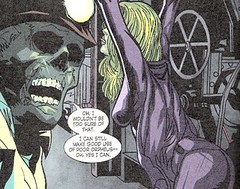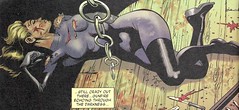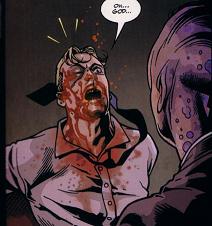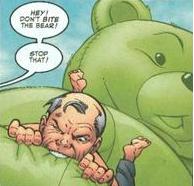Find a New Defense, Guys
We've heard it before. The defense for the objectification/over-sexualization of women. "Guys are objectified/sexualized too!" The defense for the predominance of rape or sexualized violence. "Guys are victims too!" And really no one's denying that.
But it's not a defense either.
Let's take a core issue for Girl-Wonder here. The treatment of Stephanie Brown. It's true that on one hand, I don't share their crusade for the memorialization of Steph as Robin, but there is definitely one aspect with which I agree whole-heartedly.
The inappropriateness of the sexualization of Stephanie Brown's torture. At Project Girl-Wonder, the comparison is made to Jason Todd's death as portrayed in the same series. Which is a pointed comparison indeed. However, I'd like to examine a comparison from another angle.
As it is, the defense could be made that Jason's death is portrayed differently because his death was relatively faster. It's not, one could argue, in character for the Joker to linger over his victims, to torture them, the way Black Mask does. The Joker's beatings are not as inclined to leave such decorous looking victims.
And it is true that some male characters are given quite sexualized torture/domination scenes as well. So why not, I ask myself, make the comparison with one of those? Let's see how "it happens to men, too" really applies.
Warning, Graphic Images Within
All right, first, the Stephanie Brown images (Taken from G-W.org):


Okay, I don't know about you, but I'd call that sexualized. Notice how the Spoiler costume, normally loose and unrevealing, happens to cling to every curve. Notice the arch of the back, the positioning that very much highlights breasts and hips. She's being tortured to death and she looks *sexy*. It's like something out of a snuff-fetish film.
Black Mask verbally adds to the sexualization of the scene when he says, "... you're pretty as a peach, but not exactly one of Batman's smarter minions, are you? Maybe he used you for your other, more obvious advantages, eh? Keep up morale? Keep the troops happy?"
Ick.
Now for the comparison, this is the torture of Sanderson Hawkins as seen in the JSA Elseworld, The Unholy Three:


Now, see, to me, I'd say this scene is of comparable sexualization as the first. He's not as pretty, of course. He's allowed to be blood covered. Also as he's a male character, it's a bit harder to make his sexual characteristics as obvious as they've made hers without crossing the invisible line between eroticism and pornography. However, noticing the posture and scene dynamics of the first panel, there's a faint trace of sexualization as well (in the line of the body), but nowhere near to the extent of hers. However, his subsequent panel features the villain *climbing on top of him*, which brings up the sexualization quotient to equal the first scene I think.
There's even a comparative when the bad guy, an alien, says: "...But I'll also learn everything about you. From the little-boy nicknames your mother called you, to what you prefer for breakfast each day, to the time and place you lost your virginity."
It's less overt than Black Mask's, on one sense, but the manner in which the example veers toward sex (coupled with the notion of mental invasion) could be seen to add a similar, verbal sexual component.
So yeah, it happens to men too, so we shouldn't complain, right?
Wrong. Because it happens to men *differently*.
See, even though I find the panels themselves to both be quite sexualized, that doesn't mean the circumstances involving each are even remotely the same.
The torture of Sanderson Hawkins comprised of exactly two pages. We saw the aftermath of physical torture and the initialization of the next phase (which the character will not survive). After these two pages, the story proceeded with the other characters and plot events.
The torture of Stephanie Brown encompassed an entire comic book. There were a few interlude scenes with Batman and/or Tim Drake, but the bulk of the book was devoted to this character's torture.
The torture of Sanderson Hawkins was in Unholy Three, an Elseworlds story specifically centered toward adult readers.
The torture of Stephanie Brown was in Robin, during the War Games event. Regardless of whether War Games was adult oriented or not, Robin is a book geared toward young readers. *Kids* are reading Robin.
The torture and death of Sanderson Hawkins was in an elseworld. Not in main continuity. Sure *that* version might have died quite ignobly, but the "real" heroic version remained alive and well. (And when the superhero "died", temporarily, it was during dramatic, heroic self-sacrifice.)
The torture and death of Stephanie Brown wasn't in an elseworld. That was it. The character that many people cared deeply for, tortured and died like that. Portrayed as coming from her own mistake. She doesn't get a heroic self-sacrifice. Her death is portrayed as being ultimately of her own doing.
Then to add insult to injury, remember the male victim is an adult in his early twenties. The female victim was a teenager.
And this is the kind of thing we're upset about. Even if the storyline called for Stephanie Brown to die, she didn't have to die in such a sexualized fashion, when her male counterparts had much more neutral deaths and the only comparatively sexualized scene involving a male victim that *I* can think of was in a for-mature-readers Elseworld.
There's something off there. I'm not sure what. But there is something distinctly unequal and distinctly not right. And it's something we have to stop.
But it's not a defense either.
Let's take a core issue for Girl-Wonder here. The treatment of Stephanie Brown. It's true that on one hand, I don't share their crusade for the memorialization of Steph as Robin, but there is definitely one aspect with which I agree whole-heartedly.
The inappropriateness of the sexualization of Stephanie Brown's torture. At Project Girl-Wonder, the comparison is made to Jason Todd's death as portrayed in the same series. Which is a pointed comparison indeed. However, I'd like to examine a comparison from another angle.
As it is, the defense could be made that Jason's death is portrayed differently because his death was relatively faster. It's not, one could argue, in character for the Joker to linger over his victims, to torture them, the way Black Mask does. The Joker's beatings are not as inclined to leave such decorous looking victims.
And it is true that some male characters are given quite sexualized torture/domination scenes as well. So why not, I ask myself, make the comparison with one of those? Let's see how "it happens to men, too" really applies.
Warning, Graphic Images Within
All right, first, the Stephanie Brown images (Taken from G-W.org):


Okay, I don't know about you, but I'd call that sexualized. Notice how the Spoiler costume, normally loose and unrevealing, happens to cling to every curve. Notice the arch of the back, the positioning that very much highlights breasts and hips. She's being tortured to death and she looks *sexy*. It's like something out of a snuff-fetish film.
Black Mask verbally adds to the sexualization of the scene when he says, "... you're pretty as a peach, but not exactly one of Batman's smarter minions, are you? Maybe he used you for your other, more obvious advantages, eh? Keep up morale? Keep the troops happy?"
Ick.
Now for the comparison, this is the torture of Sanderson Hawkins as seen in the JSA Elseworld, The Unholy Three:


Now, see, to me, I'd say this scene is of comparable sexualization as the first. He's not as pretty, of course. He's allowed to be blood covered. Also as he's a male character, it's a bit harder to make his sexual characteristics as obvious as they've made hers without crossing the invisible line between eroticism and pornography. However, noticing the posture and scene dynamics of the first panel, there's a faint trace of sexualization as well (in the line of the body), but nowhere near to the extent of hers. However, his subsequent panel features the villain *climbing on top of him*, which brings up the sexualization quotient to equal the first scene I think.
There's even a comparative when the bad guy, an alien, says: "...But I'll also learn everything about you. From the little-boy nicknames your mother called you, to what you prefer for breakfast each day, to the time and place you lost your virginity."
It's less overt than Black Mask's, on one sense, but the manner in which the example veers toward sex (coupled with the notion of mental invasion) could be seen to add a similar, verbal sexual component.
So yeah, it happens to men too, so we shouldn't complain, right?
Wrong. Because it happens to men *differently*.
See, even though I find the panels themselves to both be quite sexualized, that doesn't mean the circumstances involving each are even remotely the same.
The torture of Sanderson Hawkins comprised of exactly two pages. We saw the aftermath of physical torture and the initialization of the next phase (which the character will not survive). After these two pages, the story proceeded with the other characters and plot events.
The torture of Stephanie Brown encompassed an entire comic book. There were a few interlude scenes with Batman and/or Tim Drake, but the bulk of the book was devoted to this character's torture.
The torture of Sanderson Hawkins was in Unholy Three, an Elseworlds story specifically centered toward adult readers.
The torture of Stephanie Brown was in Robin, during the War Games event. Regardless of whether War Games was adult oriented or not, Robin is a book geared toward young readers. *Kids* are reading Robin.
The torture and death of Sanderson Hawkins was in an elseworld. Not in main continuity. Sure *that* version might have died quite ignobly, but the "real" heroic version remained alive and well. (And when the superhero "died", temporarily, it was during dramatic, heroic self-sacrifice.)
The torture and death of Stephanie Brown wasn't in an elseworld. That was it. The character that many people cared deeply for, tortured and died like that. Portrayed as coming from her own mistake. She doesn't get a heroic self-sacrifice. Her death is portrayed as being ultimately of her own doing.
Then to add insult to injury, remember the male victim is an adult in his early twenties. The female victim was a teenager.
And this is the kind of thing we're upset about. Even if the storyline called for Stephanie Brown to die, she didn't have to die in such a sexualized fashion, when her male counterparts had much more neutral deaths and the only comparatively sexualized scene involving a male victim that *I* can think of was in a for-mature-readers Elseworld.
There's something off there. I'm not sure what. But there is something distinctly unequal and distinctly not right. And it's something we have to stop.


15 Comments:
At June 29, 2006 4:42 AM, Anonymous said…
Anonymous said…
"And this is the kind of thing we're upset about. Even if the storyline called for Stephanie Brown to die, she didn't have to die in such a sexualized fashion, when her male counterparts had much more neutral deaths and the only comparatively sexualized scene involving a male victim that *I* can think of was in a for-mature-readers Elseworld."
as usual, a great point! Keep up the good work!
At June 29, 2006 4:58 AM, kalinara said…
kalinara said…
Thanks!
At June 29, 2006 5:12 AM, Marc Burkhardt said…
Marc Burkhardt said…
For whatever reason, many people get defensive when injustices against others are pointed out.
I'm especially thinking about the "men are objectified too" argument, or in my work as a newspaper editor when I interviewed a man who insisted that white males of European descent are the most persecuted minority of all.
And, yes, I was pretty disgusted by the manner of Stephanie's death and the lack of remorse shown by most of the Bat-family.
True, Batman himself did go to the funeral and it was one factor contributing to Cassandra's turn.
But has Tim ever really addressed his loss?
At June 29, 2006 5:16 AM, kalinara said…
kalinara said…
*nod* I think it is a valid point to make actually, in terms of figuring out exactly what's sexist and what's just cliche in a comic book.
But that doesn't mean we can't counter the examples. :-)
As for Tim:
Not as far as I know. He was at the funeral too, but it was at the same time as Jack's death so...
Well, he is a repressive type. As long as it explodes sometime during the next decade or two (meaning year or two comic time. :-P) I'll be happy.
At June 29, 2006 1:12 PM, Seth T. Hahne said…
Seth T. Hahne said…
A quibble first. Sexualization and objectification are different things. The issue you're speaking against here (regarding Spoiler's death) is sexualization rather than objectification (though I could see a case for sexual objectification). There is a time and place for both sexualization and objectification, but their overuse or inappropriate use seems almost staple in comics.
As to your point though, I pretty much agree with you all the way. Though in real life, people do occasionally (read: "rarely") die in sexualized fashion, the over-reliance upon sexualized victims in comics really is too bad. Unfortunately, from what I've seen over the years in comic stores, these kinds of stories and scenes are cartering to the majority of superhero comic consumers. DC, like Playboy, knows it's primary audience.
I'm not sure what the answer is. Change the juvenile tastes of the readers? Change company policy so as not to cater to it's primary audience? I don't know which would be easier. Especially since so many comic creators seem to be arrested in their development as well. And it's hard to trust that a company that isn't seeing the sales they want won't stoop to pandering to the baser tastes of its consumer base. In any case, it's a frustrating problem.
At June 29, 2006 1:34 PM, kalinara said…
kalinara said…
I can see what you're saying with regards to sexualization vs objectification. I'll have to consider it.
I think most readers really wouldn't mind if stuff like Spoiler's torture were a little less sexualized. There are a lot of healthy outlets for that sexuality in comics as is, and I see nothing wrong with that.
Even Spoiler's manner of death wouldn't have bothered me as much if it had been in a more mature title(preferably an elseworld, as I like my DCU to be a little more young-adult friendly...rape and death are facts of life, but I'd prefer not to see a tortured teenager quite so lovingly rendered in Robin). Robin's a series I used to recommend for my much younger cousin, so I'm particularly irked by the choice.
I'm not saying the entire DCU should be sanitized to my taste or something, but this was a bit much and I think most fans wouldn't really have minded if there were a little less detail in that particular scene.
At June 29, 2006 2:17 PM, Seth T. Hahne said…
Seth T. Hahne said…
I agree completely that most readers wouldn't have minded had the torture been less sexualized, but I'm not sure how much that plays into the predictive mindset of creators. It's kinda like with movies. Probably just as many people would have enjoyed Shakespeare in Love had Gwyneth Paltrow's nude scene never been either filmed or written in. The filmmakers added sexualization unnecessarily - presumably because they believed it would attract a larger audience (or maybe the director just really wanted to have Paltrow undress for him). I say "unnecessarily" because those scenes don't add any real value to the storytelling; someone leaving the elseworlds version of the film in which Paltrow's breasts are never unveiled wouldn't likely be thinking, "The film was good and all but I just don't understand why we didn't get any naked Paltrow? Three stars instead of the four stars it could have got!"
Of course, the whole scene may have just been the artist wanting to draw boobs and sexy poses - and though a tortured girl isn't the best for that, you take the clay you're handed and sculpt the best you can, eh? (This version of things would be more in line with the lascivious director theory on Shakespeare in Love.)
Really, i don't know what I'm talking about anymore.
As to the inclusion of the scene in Robin (a book aimed at younger readers), I'm in agreement with you. I didn't know Robin was aimed at the youthful, but if it is, those scenes are definitely inappropriate.
At June 29, 2006 3:33 PM, kalinara said…
kalinara said…
the dane: probably similar mindsets at that.
I admit, I might not have even picked up on the creepiness if Steph had been tortured in Batman and actually died (in the hospital) in Robin.
Robin's not officially, I think, aimed for younger readers. But it's *Robin*. Batman's sidekick. A kid protagonist, one people will remember vaguely from the movies/tv show (the "Robin" part at least). The Teen Titans cartoon...
The comic's always covered mature topics, like abuse, rape, death, et cetera, but usually with more subtlety befitting a comic for young and older readers. This...wasn't.
elizabeth: That's a really good point too! And rather disturbing. In the mature-oriented story, we're made to identify with the victim (which is really how it should be for maximum dramatic tension/horror, I think) and in the young adult one, we're cast as observer or torturer.
That really does shift the dynamics of what amounts to a very similar scene, doesn't it?
Though I do remember a few panels from her point of view. But only a scarce few in an entire book devoted to her torture. Ew.
At June 29, 2006 4:06 PM, Seth T. Hahne said…
Seth T. Hahne said…
Really, I'm not sure which would be worse, helpless observer to torture or being put into the head of the one being tortured. They're both decidedly uncomfortable if you at all empathize with the victim.
Hm, both Halloween and Psycho explored villainy from the criminal POV. At least it's got a celebrated precedent... :P
At June 29, 2006 4:48 PM, kalinara said…
kalinara said…
*nod* I appreciate where they're going with the technique. I just think in this case it adds to the overall dehumanization...
At June 30, 2006 9:22 PM, Erich said…
Erich said…
I hadn't seen that Spoiler-torture issue of "Robin," but from the images you've shown, all I can do is agree with your assessment:
"Ick."
At June 30, 2006 11:17 PM, kalinara said…
kalinara said…
Yeah. There were ways to get the overall impression and still be...subtle.
Clearly, subtle wasn't their intent.
At February 23, 2008 10:24 PM, Anonymous said…
Anonymous said…
I think this whole thing is more sexualized *because* she's a girl. Black Mask is very, very sadistic. He does mention that he finds her very attractive. I think Black Mask made the torture look like a fetish film because he think's it's hot.
At November 22, 2010 4:23 PM, Sildenafil said…
Sildenafil said…
indeed, inclusive male superhero need some help, specially those one who not are or have any superpower, for example Jimmy Olsen, how many time need to be saved by Superman? answer many.
At January 05, 2012 11:04 AM, online pharmacy said…
online pharmacy said…
The comic's always covered mature topics, like abuse, rape, death, et cetera, but usually with more subtlety befitting a comic for young and older readers. This...wasn't.
Post a Comment
<< Home